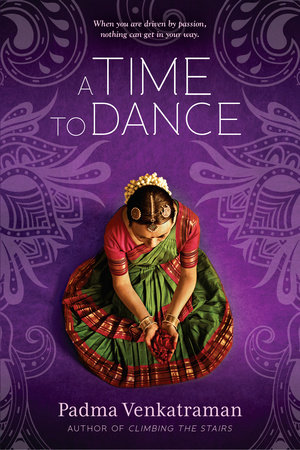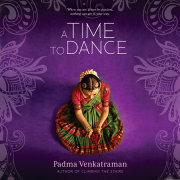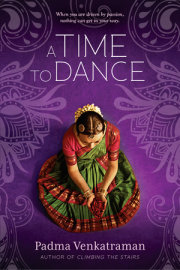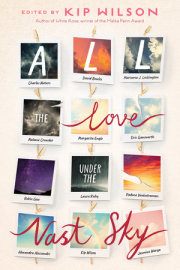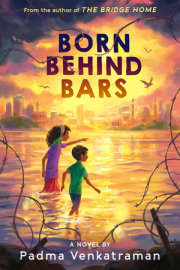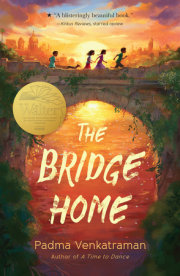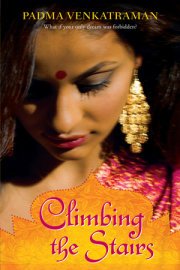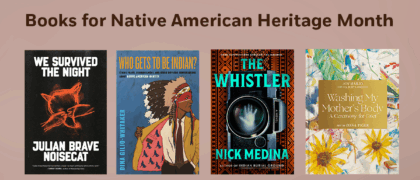PROLOGUETemple of the Dancing GodClinging to the free end of Ma’s sari,
I follow the tired shuffle of other pilgrims’ feet
into the cool darkness of the temple
where sweat-smell mingles with the fragrance of incense.
Pa’s hand rests heavy on my curls.
The priest drops a pinch of sacred ash into Ma’s palm
and she smears it on my forehead
above the red dot
she paints between my eyebrows each morning.
I push through the rustling curtain of women’s saris
and men’s white veshtis,
tiptoeing to see better.
A bronze statue of Shiva,
four-armed God of dance, glistens.
He balances on His right leg alone,
His left raised parallel to earth,
the crescent moon a sparkling jewel He wears
in His matted hair.
Carved high into the temple’s granite walls,
I spy other celestial dancers.
“Pa?” I tug at my father’s shirt.
He lifts me onto his shoulders
but the sculptures are
too far away to touch.
After the crowd empties out
into the sunshine of the temple courtyard
I, alone,
slip back
into the soft blackness of the empty hall,
spot a step-ladder propped against
my dancer-filled wall
and climb. Up, up, up, to the very top.
Leaning forward, I trace
dancing feet
with my fingertips.
“What are you doing, little one?” A priest
steadies my ladder. “You don’t have to climb
ladders to reach God.
He dances within all He creates.
Come down.”
I run my fingers
along the curve
of each stone heel.
The priest’s laugh rumbles up into my ears.
“Place a hand on your chest.
Can you feel Shiva’s feet moving inside you?”
I press on my chest. Feel bony ribs. Under them, thumping,
faint echoes of a dancing rhythm: thom thom thom.
Shiva outside me, gleaming in the temple sanctum.
Yet also leaping hidden, inside my body.
“God is everywhere. In every body. In everything.
He is born, at different times, in different places,
with different names.
He dances in heaven as Shiva, creator of universes;
He lived on earth as Buddha,
human incarnation of compassion;
And as you can see, he moves within you.
Now, please, come down, little one.”
I’m half-way down the ladder when Pa and Ma rush back in.
Pa prostrates, laying his squat body flat on the stone floor, thanking God.
Ma thanks the priest,
words of gratitude bursting from her like sobs.
“Searched—the other four temples—couldn’t find her-
—so scared—what if she’d left the temple complex—
—run outside the walls— into the city—”
As we leave, Ma’s thin fingers pinch my shoulders
tight as tongs roasting rotis over an open flame.
Pa scolds, “You could have burst your head
climbing a ladder like that!”
My head is bursting
with images
of stone dancers come alive, the tips of their bare toes twirling
with sounds
of the tiny bells on their anklets twinkling
with music.
A TIME TO DANCEHoping and WaitingI race upstairs,
kick my sandals off outside our front door,
burst into our apartment. “I’m in the finals!”
My grandmother, Paati,
surges out of the kitchen like a ship in full sail,
her white sari dazzling
in the afternoon light that streams through our open windows.
I fling my arms around her.
Drink in the spicy-sweet basil-and-aloe scent of her soap.
Paati doesn’t say congratulations. She doesn’t need to.
I feel her words in the warmth of her hug.
“I knew you’d make it.” Pa plucks me
out of Paati’s embrace into his arms.
“Finals of what?” Ma says.
I’ve only been talking
about the Bharatanatyam dance competition
for months.
Mostly to Paati, and to Pa, but Ma’s hearing is perfect
and we don’t live in a palace with soundproof walls.
Paati retreats into the kitchen.
Paati’s told me she doesn’t think it’s her place
to interfere with her son and daughter-in-law.
Pa’s eyes rove from Ma to me,
caught in the middle as always.
Ma’s diamond earrings
—the only reminder of her wealthy past—
flash at me like angry eyes.
“Veda, you need to study hard.
If you don’t do well in your exams this year—”
For once, my voice doesn’t stick in my throat. “I am studying hard.
To be a dancer.
I’m not planning to become an engineer. Or a doctor.”
Or any other profession Ma finds respectable.
Ma launches into her usual lecture. “Dancing is no career for a middle-class girl.
You need to study something useful in college so you can get a well-paid job.”
I sigh extra-loud.
My dance teacher, Uday anna, isn’t rich. But
his house is larger than ours.
Clearly, he earns more than
Ma at her bank job and Pa at his library.
Ma goes on and on.
Back when I was younger, I’d struggle to be better at school
for Ma’s sake.
But numbers and letters soon grew too large for me to hold,
and I grew far away from them
and Ma grew out of patience.
Paati places steaming sojji, my favorite snack, on our table.
The sweet, buttery smell of cooked semolina is tempting
but I leave the plate untouched.
March into the bedroom Paati and I share.
Slam the door.
Pa knocks. Says, “Come out, Veda. Eat something.”
“Leave her alone,” Ma says. “She knows where to find food if she’s hungry.”
I probably shouldn’t have slammed the door.
But Ma never even said congratulations.
She’s never pretended my dancing made her happy.
But never has a performance mattered more to me
than being chosen for the finals of this competition.
All my life, Ma’s been
hoping
I’ll do well at science and mathematics
so I could end up becoming what she wanted to be:
an engineer.
All my life, I’ve been
waiting
for her to appreciate my love
of the one thing I excel at:
Bharatanatyam dance.
Speaking with Hands “Steps came to you early. Speech came late,” Paati said.
She’d tell how she watched me pull myself up by the bars
of my cradle at eight months,
eager to toddle on my own two feet.
Months before others my age, she said,
I could shape thoughts with my fingers.
My body wasn’t shy.
While words stumbled in my throat,
losing their way long before they reached my lips,
like lotus buds blossoming, my hands spoke my first sentences
shaping themselves into hasta mudras:
the hand symbols of Indian classical dance.
Paati said, “It was as if you remembered
the sign language of Bharatanatyam
from a previous life you’d lived as a dancer
before being reincarnated as my granddaughter.”
Paati always understood everything I said with my hands.
Dance PracticeI’m a palm tree swaying in a storm wind.
My dance teacher, Uday anna,
sits crosslegged on the ground
tapping beats out on
his hollow wooden block with a stick.
I leap and land on my sure feet,
excitement mounting as Uday anna’s rhythm speeds
challenging me to repeat my routine faster.
My heels strike the ground fast as firesparks.
Streams of sweat trickle down my neck.
My black braid lifts into the air, then whips around my waist.
Nothing else fills me with as much elation
as chasing down soaring music,
catching and pinning rhythms to the ground with my feet,
proud as a hunter rejoicing in his skill.
The climax brings me to the hardest pose of all:
Balancing on my left leg, I extend my right
upward in a vertical split.
Then I bend my right knee, bring my right foot near my ear
showing how, when an earring fell off as he danced,
Shiva picked it up with his toes
and looped it back over his earlobe.
Locking my breath in my chest to keep from trembling,
I push myself to hold the pose
for an entire eight beat cycle.
A familiar thrill shoots up my spine.
I enjoy testing
my stamina, my balance.
Uday anna’s stick clatters to the floor. He claps.
“Pull that off and you’re sure to win.”
Both feet on the ground again, I piroutte and leap,
rejoicing in the speed at which
my body obeys my mind’s commands,
celebrating my strong, skilled body—
the center and source of my joy,
the one thing I can count on,
the one thing that never fails me.
Copyright © 2015 by Padma Venkatraman. All rights reserved. No part of this excerpt may be reproduced or reprinted without permission in writing from the publisher.

